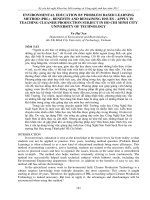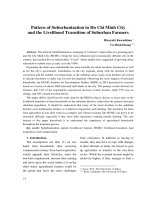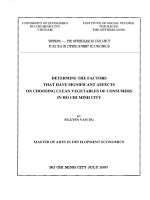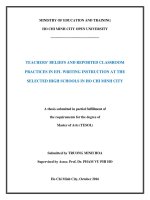From the Mariamman temple in Hồ Chí Minh city thinking of the goddess cult of Vietnamese
Bạn đang xem bản rút gọn của tài liệu. Xem và tải ngay bản đầy đủ của tài liệu tại đây (733.35 KB, 6 trang )
74
giáo. Số 11 – 2014
Religious Studies. No. 3&4 - 2015
74
NGUYỄN THỊ TÂM ANH*
FROM THE MARIAMMAN TEMPLE IN HỒ CHÍ MINH CITY
THINKING OF THE GODDESS CULT OF VIETNAMESE
Abstract: The Mariamman temple was the place of worship for
Indian community in Hồ Chí Minh City. Indian has built many
places of worship since they have settled in Sài Gòn. At present,
there are three places of worship for the Hindu Indian such as the
Mariamman temple (called the Goddess pagoda - Chùa Bà, the
Goddess pagoda of Hinduism - Chùa Bà Ấn giáo, the Black
Goddess pagoda - Chùa Bà Đen), the Subramanian Swami temple
(called the God pagoda - Chùa Ông), and the Sri Thenday
Yutthapani temple. Especially, the Goddess Mariamman temple is
an attractive place of worship for Vietnamese as well as Indian
while two other male God temples are solitary which intended for
the Indian. Whether the differences derived from the cult of
goddess that imprinted in Vietnamese culture or not? This paper
tries to answer this question.
Keywords: Goddess pagoda, Goddess pagoda of Hinduism, Black
Goddess pagoda, Mariamman temple, cult of goddess.
1. An overview on the history of the Mariamman Temple
In 1867, French occupied the Southern region and built a city at the
border gate of Saigon. Then, in the end of the 19th century, the French
East India Company controlled some states in India, the French moved
Tamil people from Pondicherry and Karaikal colonies located along the
southern coast of India to Saigon. In Saigon, these Indian involved in the
business in various fields, especially in credit, real estate and textiles.
Over the time, they founded a number of Hinduism temples as places for
religious practice in Vietnam1.
According to the data of the management Board of the Mariamman
temple, the temple was built by the Indian community in the early of the
20th century. Initially, it was only a small temple for Hindu. In 1950, the
temple was rebuilt according to the architectural style of a Hindu temple,
*
MA., The Open University of Ho Chi Minh City.
Nguyễn Thị Tâm Anh. From the Mariamman Temple...
75
South of India by Tamil people of the Indian Overseas Association in
Saigon. Many materials and statues in temples were imported from India.
The Mariamman temple was experiencing the abandonment period.
Since 1990, this temple has worked again under the governance of an
Indian businessman who was a grandson of the previous manager (pass
away in 2005). Currently, the temple is managed by a Management Board
appointed by the government of the district 1.
2. An overview on the goddess Mariamman
Mariamman, in Tamil or Marathi language, means mother Mari, which
also means rain or change. She was worshiped as the goddess of fertility
with the ability to bring good weather; she also was the goddess of
smallpox and measles, herds of grandchildren; she also was a matchmaker.
The Goddess Mariamman very revered in the South of India,
particularly in rural areas of Tamil Nadu, Karnataka, Andhra Pradesh and
Maharashtra states. Many researchers stated that Mariamman was an
ancient Goddess of the Dravidian tribe before the appearance of the Aryan
people. Dravidian people worshiped this Goddess to pray for good weather
because their life depended on the agriculture2. Currently, the Mariamman
Goddess is worshipped all over India and where the Indian lives.
There were many legends about the origin of the Mariamman Goddess
cult. The first legend said that Mariamman was the wife of Thiruvalluvar, a
Tamil poet who belonged to the lowest caste, so she was estranged from
people. She was infected smallpox and she had to beg for food from one
house to another; she used the Margosa leaves to stop flying into ulcers in
her body. Then she recovered miraculously. People began to worship her
as the Goddess of smallpox. Since, the Indians have had the custom of
hanging Margosa leaves3 on the doors to scare away smallpox4.
The second legend mentioned a beautiful and virtuous woman named
Nagavali, wife of Perahu, one of nine Rishi5. One day, Rishi went far away
and Trimurti (the trinity of Brahma, Vishnu, Shiva) came to admire her
famous beauty and virtue. Nagavali did not know them; she was angry at
their intrusion; she turned them into kids. The Gods were insulted and they
cursed her. So her beauty disappeared and her face appeared spots of
smallpox. Rishi came back, found her disfigurement, he sent her away, and
he also said: you would give birth a demon afterlife. It will spread smallpox
for other people like you6. Thus, you are called Mari, it means change.
76
Religious Studies. No. 3&4 - 2015c
Mariamman was often described as a beautiful young woman with red
face, red dress. Sometimes, she was described that she held multiple
weapons to denote her power. In general, she was often described with
two manners, a gentle, pleasant manners, while the other one was fierce
with fangs and shaggy hair.
The Mariamman Goddess had three basic characteristics as follow:
Firstly, Mariamman was the goddess of villages. India was an
agricultural country, the culture was originated from the context of rural
life. In the villages, residents worshipped the village deities
(gramadevata). A village may have many village gods, each one of which
had its own function. Mariamman was one of the goddesses that was
worshiped mostly in the South of India. She was often represented by a
rock. She was a guardian deity of the village boundaries. The village was
considered as a complete universe, the central power of the village
belonged to the Goddess.
Secondly, Mariamman was the goddess of illness treatment. Indian
believed that the Mariamman Goddess cured smallpox and measles.
During the summer months (from March to June) in the South of India,
people carried a pot of water mixed with margosa leaves and turmeric
powder to prevent smallpox and measles. In this way, the Maramman
Goddess liked the Shitala Goddess in the North of India.
Thirdly, Mariamman was the goddess of reproduction. The Hindu
often worshiped Mariamman for family issues such as reproduction,
healthiness, marriage with a matched husband/wife. Indians often offered
Pongal (rice cooked with green beans) to this Goddess7. Today, at the
Mariamman temple in Ho Chi Minh City, the Indians still make these
offerings to worship her.
3. The architecture and religious activities at the Mariamman
temple
The Mariamman Temple was built on a large scale with domes and
pillars which were the features of the Indian architecture. The main
shrine dedicated to the Parvati Goddess, the incarnation of the
Mariamman Goddess. There were two guardians beside the Mariamman
Goddess: Maduraiveeran was on the left and Pechiamman was on the
right. In front of the Mariamman Goddess, there were two linga; one was
placed on the yoni, the other was placed on a lower stone pedestal. This
Nguyễn Thị Tâm Anh. From the Mariamman Temple...
77
forbidden area was surrounded by an iron fence, only the person who
prepared for the ceremony could come in. Outside the fence, there was a
wide lobby where placed the offerings such as incense, fruits, rice, salt,
oil, etc… Above the statue of Mariamman, there were two statues of her
sons, Ganesha and Murugan in respectful status. There were two small
shrines dedicated to Cô (a little girl) and Cậu (a little boy). All three
statues of Mariamman, Cô and Cậu were made of stone painted black,
statues’ necks and hands wearing jewelry such as gold, silver and
gemstones. Besides, the roof of these three shrines had beautiful statues
of deities and animals with multicolor.
Outside the yard, there was a back house with the U-shaped.
Remarkably, on the wall of the back house had 18 statues of deities with
different posture and manners which were set in circular domes, designed
meticulously and painted bright colors. Below each statue had a name
attached such as Nadarajar, Paramsiva, Brahman, Mahavishu,
Kaliamman, Biaramasakthi, Samundi, Thirumagal, Mageswari,
Meenadchi, Vaslambigai, Andal, Kamadchiamman, Karumariamman,
Sivagami, Parvathy và Murgan. There were the three supreme deities of
Hinduism as Brahma, Vishnu and Shiva in three corners. Please refer to
the specific diagram below:
Besides, the Mariamman temple also had a very large lion (Simha
vahanam), located at the main gate. This lion was an animal for riding of
the Mariamman Goddess. Thus, when people came to the temple, they
stopped for worshiping this lion to pray for peace, to banish sorrow in
their heart.
Religious Studies. No. 3&4 - 2015c
78
The ritual of the Mariamman temple was organized every day, mainly
from 8 to 9 AM and from 7 to 8 PM. The solemn ceremony was held on
every Friday (day of the Shakti Goddess, the incarnation of Mariamman
according to the Hindu tradition), the first day and the full moon day
every month (according to Vietnamese tradition) had one more ritual
from 10 to 11 AM.
The Mariamman temple’s Festival was called Vía Bà, held in
September or in October every year. During this ceremony, many
backwards arrows were made of young coconut leaves and were hanged
everywhere in the temple mixed with mango leaves. In comparison with
the Indian culture, this was the time of the Navratri festival, which
worshiped the incarnation of Durga and the last day was the day the
Goddess came back in the most complete incarnation: Parvati. Therefore,
in my opinion, the Mariamman Goddess is worshiped in this temple as
the most complete form of the incarnation of the Parvati Goddess. This is
the cult of the Goddess in the Indian culture.
The other interesting thing is that, after offering incense and offerings,
visitors usually receive a gift of the temple as jasmine, it often combined
into a necklace. Recipients often put flower buds on the altar or soak in
the bath water as a ritual for good luck.
4. Conclusion
The Mariamman temple serviced for religious needs and gathering of
the Indian community in Hồ Chí Minh City. However, we can clearly see
the acculturation in these places of worship. During a long term of coexistence with Vietnamese, the Indian culture was influenced by many
factors according to the rule and development of nature and society. This
temple has not only attracted Indians, but it has also been attracting the
other ethnic groups. In my opinion, the cause has led to this phenomenon
that the Mariamman temple has not only been the place of worship for
the Indian community.
Since its reconstruction in 1950, the temple has opened to welcome
Việt people, even Chinese or Khmer people. Everybody has sincerely
offered offerings to the deities in the Mariamman temple that were
unfamiliar with their culture. It is possible that the Cult of the Goddess
has had a long history of the Vietnamese culture. This type of worship
has aimed to the earthly life, such as health, fortune, luck. Therefore, the
Nguyễn Thị Tâm Anh. From the Mariamman Temple...
79
Goddess cult of the Indian has quickly integrated into Vietnamese culture
and it has become an original culture in Vietnam. Besides, the receiving
the Mariamman Goddess on the spiritual life of Vietnamese in Hồ Chí
Minh City has been likely due to the location of this temple was once a
small temple where worshiped the Goddess Linh Sơn (Linh Sơn Thánh
Mẫu). Thus, when the Mariamman temple was completed, the residents
lived around the temple area come to worship and pray.
Both the Cult of the Mariamman Goddess in the Indian culture and the
Cult of Goddess in the Vietnamese culture have been formed and
developed since thousands years ago. They manifested the conception of
the universe and the conception of life. It expressed admiration the
person for the birth, nurture and retaining race, the material and spiritual
fulcrum, the immense protection. The supernatural phenomena gradually
associated with the motherhood, the mother became the supernatural
mother. The mother was idolized in human life. Therefore, the Cult of
Goddess also manifested the humanity of Vietnamese. /.
Notes:
1
2
3
4
5
Http://en.wikipedia.org/wiki/History_of_Puducherry
Http://en.wikipedia.org/wiki/Mariamman
Margosa leaves often used to treat skin diseases by the Indians.
Http://en.wikipedia.org/wiki/Mariamman
The sage has an unobstructed view, self-cultivation yoga to reach the Dhatu
(realm) to merge with things.
6 Http://en.wikipedia.org/wiki/Mariamman
7 Đoàn Hoài Nam (2013), Tìm hiểu về đền Mariamman tại Thành phố Hồ Chí
Minh, Báo cáo thực tập tốt nghiệp, Trường Đại học Mở Thành phố Hồ Chí Minh
[Research on the Mariamman Temple in Hồ Chí Minh City, Report graduation
exercises, the Open University of Hồ Chí Minh City].
References:
1. Nguyễn Thị Tâm Anh (2013), Manuscript field materials.
2. Đoàn Hoài Nam (2013), Tìm hiểu về đền Mariamman tại Thành phố Hồ Chí
Minh, Báo cáo thực tập tốt nghiệp, Trường Đại học Mở Thành phố Hồ Chí Minh
[Research on the Mariamman Temple in Hồ Chí Minh City, Report graduation
exercises, the Open University of Hồ Chí Minh City].
3. Ngô Đức Thịnh (2014), Đạo thờ Mẫu ở Việt Nam Nxb. Thời đại, Hà Nội [The
Mother Goddess in Vietnam, Hnoi: The Time].
4. Http://en.wikipedia.org/wiki/Mariamman
5. Http://www.philtar.ac.uk/encyclopedia/hindu/ascetic/mariam.html
6. Http://en.wikipedia.org/wiki/History_of_Puducherry
7. Http://daidoanket.vn/PrintPreview.aspx?ID=64809
8. Http://vov.vn/Van-hoa/Van-hoa-tho-nu-than-o-Viet-Nam-va-ChauA/226684.vov









